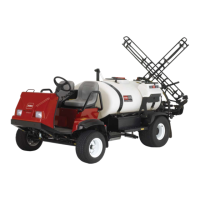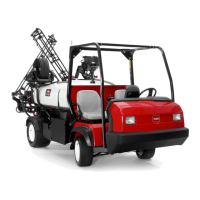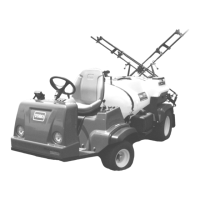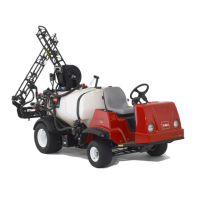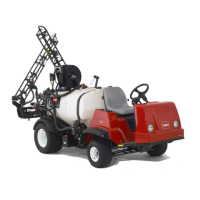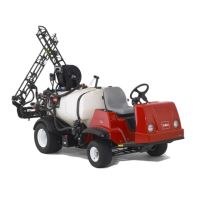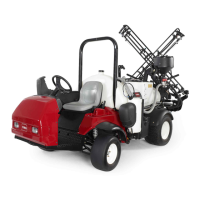Multi Pro 5800 Hydraulic SystemPage 5 − 27
4. The inlet and the outlet hoses for tester with pressure
and flow capabilities must be properly connected. If
hoses are reversed, damage to the hydraulic tester or
components can occur.
5. When using hydraulic tester with pressure and flow
capabilities, completely open tester load valve before
starting engine to minimize the possibility of damage to
components.
6. Install tester fittings finger tight and far enough to
make sure that they are not cross−threaded before tight-
ening them with a wrench.
7. Position tester hoses to prevent rotating machine
parts from contacting and damaging the hoses or tester.
8. Check oil level in the hydraulic reservoir. After con-
necting test equipment, make sure reservoir is full.
9. Check control linkages for improper adjustment,
binding or broken parts.
10.After installing test gauges, run engine at low speed
and check for any hydraulic oil leaks.
11.All hydraulic tests should be made with the hydraulic
oil at normal operating temperature.
12.Before returning machine to use, make sure that hy-
draulic reservoir has correct fluid level. Also, check for
hydraulic leaks after test equipment has been removed
from hydraulic system.
Which Hydraulic Tests Are Appropriate
Before beginning any hydraulic test, identify if the prob-
lem is related to the traction circuit, spray pump drive cir-
cuit, steering circuit or spray boom lift circuit. Once the
faulty system has been identified, perform tests that re-
late to that circuit.
1. If a traction circuit problem exists, consider perform-
ing one or more of the following tests: Traction Circuit
Charge Pressure, Traction Circuit Relief Pressure,
Wheel Motor Efficiency, Charge Pump Flow and/or Pis-
ton (Traction) Pump Flow Tests.
IMPORTANT: Refer to Traction Circuit Component
Failure in the General Information section of this
chapter for information regarding the importance of
removing contamination from the traction circuit af-
ter a component failure.
2. If a steering circuit problem exists, consider perform-
ing one or more of the following tests: Steering and
Boom Lift/Lower Circuit Relief Pressure, Steering Cylin-
der Internal Leakage and/or Steering and Boom Lift/
Lower Gear Pump Flow Tests.
3. If a spray pump drive circuit problem exists, consider
performing one or more of the following tests: Spray
Pump Drive Circuit Pressure, Spray Pump Drive Relief
Pressure or Spray Pump Drive Gear Pump Flow Tests.
4. If a spray boom lift/lower circuit problem exists, con-
sider performing one or more of the following tests:
Steering and Boom Lift/Lower Circuit Relief Pressure
and/or Steering and Boom Lift/Lower Gear Pump Flow
Tests.
Hydraulic
System

